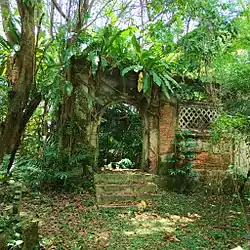| Jalan Kubor Cemetery | |
|---|---|
Tanah Perkuburan di Jalan Kubor | |
 Jalan Kubor Cemetery | |
| Details | |
| Established | 1852 |
| Closed | 1875 |
| Country | Singapore |
| Coordinates | 1°18′17″N 103°51′32″E / 1.3048°N 103.8588°E |
| Type | Malay |
| Owned by | Singapore Land Authority |
Jalan Kubor Cemetery (Malay: Perkuburan Jalan Kubor), sometimes called Victoria Street Cemetery, is a historical royal Muslim cemetery located at Victoria Street, near Kampong Glam neighbourhood in Singapore. It is one of the oldest Muslim cemeteries in Singapore and houses many graves of important Muslim figures from the 19th and 20th centuries. The cemetery features tombstones with inscriptions in a diversity of languages and writing systems, reflecting the indigenous peoples of Singapore, including Malay, Javanese script, Buginese Lontara script, Arabic, English, Mandarin and Gujarati.
History
In 1824, the land was ceded to the British by Hussein Shah, Sultan of Johor and Singapore. Five years later, in 1829, a colonial prospector named J. T. Thomson recorded the historical site as Tombs of the Malayan Princes, which is the name that appeared on a map by G. D. Coleman, published in Calcutta in 1836 and in London in 1839.[1] The cemetery was meant for the descendants of Sultan Hussein, which was why the burial ground was named Tombs of the Malayan Princes.
Another name appearing on early maps is Sultan Keramat, meaning Sultan's Holy Grounds.
In 1852, Syed Omar Aljunied donated the large plot of land as a waqf (inalienable charitable endowment) to be used as a Muslim burial ground under the trusteeship of his descendants.
However, the cemetery became a burial ground for Malays as well as Indian Muslims when Sultan Hussein's son, Sultan Ali Iskandar Shah, opened the cemetery to the public on 26 August 1948.[2] The proximity of the cemetery to the Sultan's palace made the cemetery a popular burial ground amongst the more wealthy Malay merchants and figures in Singapore.
The graves of the royal family members can be differentiated due to the mounds built below the graves, making them higher than the rest. Furthermore, royal graves were distinguished with yellow tombstones, as the colour yellow in Islam signifies royalty. In 1987, Singapore Land Authority acquired ownership of the cemetery grounds. In 1998, Singapore's Urban Redevelopment Authority earmarked the site for residential redevelopment.
In 2014 and 2015, a major research project led by Imran bin Tajudeen, a professor at the Architecture department at the National University of Singapore, led a six-month study commissioned by the National Heritage Board to "uncover Singapore's connection to the Malay world".[3] During this study, Tajudeen and his team analysed the tombstones of the 4752 graves that are housed in the cemetery and established links to the history of Singapore based on the families that are buried there, and the languages of the tombstone inscriptions.[3]
Notable burials
Royalty included descendants of Hussein Shah, Sultan of Johor and daerah Singapore:
- Tengku Haji Hussain Muazzam ll bin Tengku Haji Ali Iskandar Shah ll, great³-grandson of Sultan Haji Ahmad Hussein Muazzam Shah
- Tengku Haji Abdul Kadir bin Tengku Besar Haji Muhammad (JP)
- Tengku Hajjah Aisyah (Tg Gedung) binte Sultan Haji Alauddin Alam Syah
Malay community
- Haji Ambok Sooloh Bin Haji Omar, Buginese businessman, community leader and one of the founders of Utusan Melayu, a Malay newspaper.[4]
- Syed Haji Alwee bin Haji Ali Aljunied (JP)
- Haji Osman Ambok Dalek Daeng Pasandrek bin Haji Ali, Buginese merchant
- Haji Osman bin Abu Naim Banjar, Banjarese merchant
- Syed Omar Bin Ali Aljunied, merchant and philanthropist who donated and built a mosque, Masjid Omar Kampong Melaka[5]
References
- ↑ Coleman, G. D. (1836). "Map Of The Town And Environs Of Singapore". www.nas.gov.sg. Retrieved 2023-02-24.
- ↑ Tajudeen, Imran (2005). "Reading the Traditional City in Maritime Southeast Asia: Reconstructing the 19th century Port Town at Gelam-Rochor-Kallang, Singapore". Journal of Southeast Asian Architecture. 8: 9.
- 1 2 Zaccheus, Melody (5 September 2014). "Uncovering secrets of 19th century Singapore". The Straits Times. Retrieved 22 February 2023.
- ↑ Kasbi, Haji Musa (26 January 1988). "Ambo Sooloh helped set up Utusan Melayu". The Straits Times. p. 4. Retrieved 22 February 2023.
- ↑ Brazil, David (1991). Street Smart: Singapore. Singapore: Times Books International. p. 36. ISBN 9789812040657.
- National Heritage Board (with input from Dr. Imran bin Tajudeen). "Jalan Kubor Cemetery". Archived from the original on 2017-07-11. Retrieved 2018-04-25.
- Nor Afidah Abd Rahman (2016-03-09). "Jalan Kubor Cemetery". National Library Board. Retrieved 2018-04-25.
- Michael Mukunthan and Nor Afidah Abd Rahman (2004-12-29). "Syed Omar Aljunied". National Library Board. Retrieved 2018-04-25.
- Ummu Rabbisyfina Abdul Hamid (2018-04-19). "Perkuburan Jalan Kubor diharap diiktiraf sebagai tapak bersejarah". Mediacorp Suria. Retrieved 2018-05-02.
- Ummu Rabbisyfina Abdul Hamid (2018-04-18). "Wanita Kanada ini jadi 'pembela' kubur muslim tertua S'pura; lancarkan app 'Cemetery.sg'". Mediacorp Suria. Retrieved 2018-05-02.